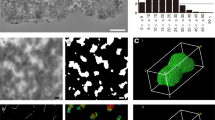Abstract
THE chromatin of the interphase cell nucleus has been divided into two types on histochemical and ultrastructural grounds. Electron microscopy has shown heterochromatin or condensed chromatin to have a structure of densely compacted fibrils, whereas euchromatin shows a looser arrangement of similar fibrils. Demarcation between these two types is sharp, but there is continuity of fibrils between them1. Microspectrophotometric measurements of Feulgen-stained nuclei have shown that heterochromatin contains DNA two to three times as concentrated as in euchromatin2. It is rendered more electron dense by the uranyl stain used in electron microscopy3. Cells which are inactive in nucleic acid synthesis usually have a pachychromatic nuclear pattern with more heterochromatin than those which are more active.
This is a preview of subscription content, access via your institution
Access options
Subscribe to this journal
Receive 51 print issues and online access
$199.00 per year
only $3.90 per issue
Buy this article
- Purchase on Springer Link
- Instant access to full article PDF
Prices may be subject to local taxes which are calculated during checkout
Similar content being viewed by others
References
Frenster, J. H., Nature, 205, 1341 (1965).
Lima de Faria, A., Biochim. Biophys. Acta, 6, 457 (1959).
Littau, V. C., Allfrey, V. G., Frenster, J. H., and Mirsky, A. E., Proc. US Nat. Acad. Sci., 52, 93 (1964).
Granboulan, N., and Granboulan, P., Exp. Cell Res., 38, 604 (1965).
Karasaki, S., J. Cell Biol., 26, 937 (1965).
Hay, E. D., and Revel, J. P., J. Cell Biol., 16, 29 (1963).
Coulson, A. S., and Chalmers, D. G., Lancet, ii, 468 (1964).
Caro, L. G., and van Tubergen, R. P., J. Cell Biol., 15, 173 (1962).
Robbins, E., and Gonatas, N. K., J. Cell Biol., 21, 429 (1964).
Johnson, F. R., and Roberts, K. B., J. Anat., 98, 303 (1964).
Blondel, B., and Tolmach, L. J., Exp. Cell Res., 37, 497 (1965).
Inman, D. R., and Cooper, E. H., Acta Haematol. (Basel), 33, 257 (1965).
Lima de Faria, A., Reitalu, J., and O'Sullivan, M. A., Chromosoma, 16, 152 (1965).
Epstein, L. B., and Brecher, G., Blood, 26, 197 (1965).
McKinney, A. A., Blood, 26, 36 (1965).
Cooper, E. H., Hale, A. J., and Milton, J. D., Acta Haematol. (Basel), 38, 1 (1967).
Littau, V. C., Burdick, C. J., Allfrey, V. G., and Mirsky, A. E., Proc. US Nat. Acad. Sci., 54, 1204 (1965).
Allfrey, V. G., Cancer Res., 26, 2026 (1966).
Author information
Authors and Affiliations
Rights and permissions
About this article
Cite this article
MILNER, G., HAYHOE, F. Ultrastructural Localization of Nucleic Acid Synthesis in Human Blood Cells. Nature 218, 785–787 (1968). https://doi.org/10.1038/218785a0
Received:
Revised:
Issue Date:
DOI: https://doi.org/10.1038/218785a0
This article is cited by
-
Effects of α-amanitine on chromatin in regenerating rat hepatocytes
Virchows Archiv B Cell Pathology (1976)
-
Euchromatisierung menschlicher Lymphocyten durch Phytohämagglutinin
Research in Experimental Medicine (1974)
-
Fine structure of interphase nuclei
Chromosoma (1973)
-
Changes in Chromatin Structure during Interphase in Human Normoblasts
Nature (1969)
-
Untersuchungen an Nucleohistonen
Klinische Wochenschrift (1969)
Comments
By submitting a comment you agree to abide by our Terms and Community Guidelines. If you find something abusive or that does not comply with our terms or guidelines please flag it as inappropriate.



